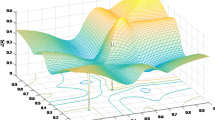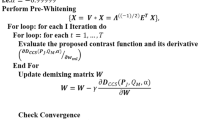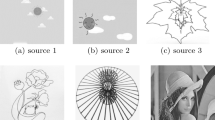Abstract
A simplicial cone can be employed in nonnegative blind source separation (N-BSS). Nevertheless, the coordinate origin may not be a dark-point, and in this case, it is challenging to implement N-BSS with a simplicial cone. We propose an algorithm for finding dark-points based on the minimum Jaccard index (MJI) criterion-dark-point component analysis (DCA). This method only needs to assume source boundedness and nonnegativity instead of local dominance, full additivity, and sparsity. On the other hand, mixing data scatter plots are usually confined as tear-drop-shaped or deltoid. However, DCA does not need such restrictions. DCA can also be applied to blind source separation (BSS) in which the sources are strictly positive, and the result is the same as that of N-BSS.















Similar content being viewed by others
Data Availability Statement
In the manuscript entitled ‘Dark-Point Component Analysis: Nonnegative Blind Source Separation Based on Jaccard Index’, all the authors agree that the data that support the findings of this study are available from the authors upon reasonable request.
References
M. Babaie-Zadeh, C. Jutten, A. Mansour, Sparse ica via cluster-wise pca. Neurocomputing 69(13–15), 1458–1466 (2006)
M. Babaie-Zadeh, A. Mansour, C. Jutten, F. Marvasti, A geometric approach for separating several speech signals (2004)
T. Chan, C. Chi, Y. Huang, W. Ma, A convex analysis-based minimum-volume enclosing simplex algorithm for hyperspectral unmixing. IEEE Trans. Signal Process. 57(11), 4418–4432 (2009)
P. Comon, C. Jutten, Handbook of Blind Source Separation: Independent Component Analysis and Applications (Academic press, Cambridge, 2010)
M.D. Craig, Minimum-volume transforms for remotely sensed data. IEEE Trans. Geosci. Rem. Sens. 32(3), 542–552 (1994)
D. Donoho, V. Stodden, When does non-negative matrix factorization give correct decomposition into parts?. Adv. Neural Inf. Process. Syst. 16 (2004)
C. Gobinet, E. Perrin, R. Huez, Application of non-negative matrix factorization to fluorescence spectroscopy (2004)
R. Gribonval, M. Zibulevsky, Sparse component analysis, in Handbook of Blind Source Separation. (Elsevier, Amsterdam, 2010), pp. 367–420
E. Hendrix,I. García Fernandez, J. Plaza, A. Plaza, On the minimum volume simplex enclosure problem for estimating a linear mixing model. J. Global Optim. (2013).https://doi.org/10.1007/s10898-012-9876-5
C.M. Hwang, M.S. Yang, New similarity measures between generalized trapezoidal fuzzy numbers using the Jaccard index. Int. J. Uncertain. Fuzz. Knowl.-Based Syst. 22(06), 831–844 (2014)
D. Lee, H. Seung, Learning the parts of objects by non-negative matrix factorization. Nature 401, 788–91 (1999). https://doi.org/10.1038/44565
J.S. Lee, D.D. Lee, S. Choi, D.S. Lee, Application of nonnegative matrix factorization to dynamic positron emission tomography. In: 3rd International Conference on Independent Component Analysis and Blind Signal Separation, pp. 556–562 (2001)
L. Leydesdorff, On the normalization and visualization of author co-citation data: Salton’s cosine versus the Jaccard index. J. Am. Soc. Inf. Sci. Technol. 59(1), 77–85 (2008)
C. Lin, C. Chi, Y. Wang, T. Chan, A fast hyperplane-based minimum-volume enclosing simplex algorithm for blind hyperspectral unmixing. IEEE Trans. Signal Process. 64(8), 1946–1961 (2016)
C. Lin, W. Ma, W. Li, C. Chi, A. Ambikapathi, Identifiability of the simplex volume minimization criterion for blind hyperspectral unmixing: The no-pure-pixel case. IEEE Trans. Geosci. Rem. Sens. 53(10), 5530–5546 (2015)
L. Miao, H. Qi, Endmember extraction from highly mixed data using minimum volume constrained nonnegative matrix factorization. IEEE Trans. Geosci. Rem. Sens. 45(3), 765–777 (2007)
J.M.P. Nascimento, J.M.B. Dias, Vertex component analysis: a fast algorithm to unmix hyperspectral data. IEEE Trans. Geosci. Rem. Sens. 43(4), 898–910 (2005)
W. Ouedraogo, A. Souloumiac, M. Jaidane, C. Jutten, Geometrical Method Using Simplicial Cones for Overdetermined Nonnegative Blind Source Separation: Application to Real PET Images (Springer, Berlin, Heidelberg, 2012)
W.S.B. Ouedraogo, A. Souloumiac, M. Jaidane, C. Jutten, Simplicial cone shrinking algorithm for unmixing nonnegative sources. In: 2012 IEEE International Conference on Acoustics, Speech and Signal Processing (ICASSP), pp. 2405–2408 (2012)
W.S.B. Ouedraogo, A. Souloumiac, M. Jaïdane, C. Jutten, Non-negative blind source separation algorithm based on minimum aperture simplicial cone. IEEE Trans. Signal Process. 62(2), 376–389 (2014)
C.G. Puntonet, A. Prieto, Neural net approach for blind separation of sources based on geometric properties. Neurocomputing 18(1–3), 141–164 (1998)
E. Rathod, N. Gavankar, A survey of vertex component analysis: Hyperspectral data unmixing process. In: 2014 International Conference on Innovations in Engineering and Technology, vol. 3, pp. 1997–2002 (2014)
P. Rigo, P. Paulus, B. Kaschten, R. Hustinx, T. Bury, G. Jerusalem, T. Benoit, J. Foidart, Oncological applications of positron emission tomography with fluorine-18 fluorodeoxyglucose. Eur. J. Nucl. Med. 23, 1641–74 (1997). https://doi.org/10.1007/BF01249629
H. Zayyani, M. Babaie-Zadeh, C. Jutten, An iterative Bayesian algorithm for sparse component analysis in presence of noise. IEEE Trans. Signal Process. 57(11), 4378–4390 (2009). https://doi.org/10.1109/TSP.2009.2025154
M. Zhao, Z. Wang, Z. Zhao, Z. Dong, Z. Zhang, The algorithm for nonnegative blind source separation using edge feature (Signal, Image and Video Processing, 2021), pp. 1–8
Acknowledgements
This work is supported by National Key Research and Development Program(Grant No. 2017YFB1002804): Multimodal Data Interaction Intention Understanding in Cloud Fusion and Major Project of National Social Science Foundation of China (Grant No.17ZDA331): Methodology Research on Thinking of Chinese Medicine (2017-2022). This work is also supported by Hebei Province technology innovation guidance program - Winter Olympics with science and technology special funding project: Research on high precision positioning technology of ice and snow emergencies under 5G VR scene (project number: 20470302d).
Author information
Authors and Affiliations
Corresponding author
Ethics declarations
Conflicts of interest
All authors declare there is no conflict of interest.
Additional information
Publisher's Note
Springer Nature remains neutral with regard to jurisdictional claims in published maps and institutional affiliations.
Rights and permissions
About this article
Cite this article
Zhao, M., Wang, Z., Chang, X. et al. Dark-Point Component Analysis: Nonnegative Blind Source Separation Based on Jaccard Index. Circuits Syst Signal Process 41, 3985–4003 (2022). https://doi.org/10.1007/s00034-022-01969-w
Received:
Revised:
Accepted:
Published:
Issue Date:
DOI: https://doi.org/10.1007/s00034-022-01969-w




